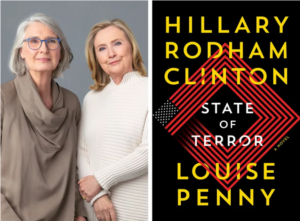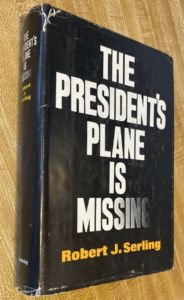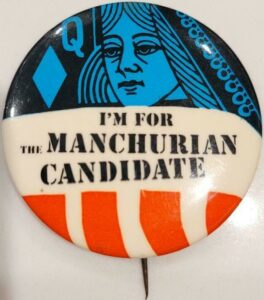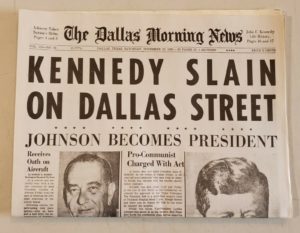Capitol Crimes – Intrigue in the Executive, Legislative, and Judicial Branches
Mystery Scene, Spring 2022
There’s big trouble at the Executive Mansion. Treachery, deceit, infidelity, murder. And that’s just the short list.
Things aren’t much better down at the end of the National Mall, just two and a half miles away, at the Capitol Building.
And don’t even ask what’s happening at the Supreme Court.
It may be an election year, but all the slings and arrows from the warring candidates and their respective parties can’t compare to the ominous weaponry and sinister plots perpetrated in the fictional world of political thrillers.
With so much action currently emanating from White House and D.C. environs, it seems apt to explore fictional thrillers related to the presidency – and the capital that is the heartbeat of American democracy.
Like governments, political thrillers come in all forms. Some anticipate true history, others bank on it. Many reflect contemporary anxieties.
The genre has a cadre of leading authors whose names are as unmissable as the cover artwork of their books. The roster includes David Baldacci, Nelson DeMille, Vince Flynn, Brad Meltzer, Daniel Silva … Book dust jackets often depict the White House or the domed crown of the Capitol building, and are emblazoned with superlatives like “propulsive,” “nail-biting,” “blistering,” “explosive,” and “page-turning.”
Explaining the genre’s appeal, writer Matthew Quirk suggests, “People like to pull back the curtain on iconic institutions, and they like thrillers with high stakes. And it doesn’t get much more iconic or high stakes than 1600 Penn.” The author of half a dozen titles, including 2020’s Hour of the Assassin, about a former Secret Service agent on the run and a presidential candidate with a dark secret, Quirk stresses that well-drawn characters are necessary components for a reader’s “emotional investment.”
When the U.S. presidency is involved, he adds, the attraction is “the natural intrigue and fascination that comes with the most powerful job in the world.”
Quirk’s relevant job history includes having worked as a reporter in DC (he twice visited the White House), making him part of the constituency of journalists-turned-authors. Call it the genre press corps.
Still other contributors migrated to the field after genuine hands-on government work. These “insiders” – onetime spies, military members, politicians, staffers, and others – are known for bringing serious street cred to their novels.
Few authors can say, authoritatively, “I was in the Situation Room the night we bombed Libya.” For Karna Small Bodman it was one of many memorable experiences with the Reagan White House, where the former TV newscaster spent six years as deputy press secretary, then served as senior director of the National Security Council. During her tenure, Bodman had almost daily meetings with Reagan, and traveled on Air Force One for international trips that included arms control talks with the Soviets.
The author of five political thrillers boasting a female protagonist, Bodman reads a stack of newspapers daily, clipping articles that might be useful. (“The Wall Street Journal is my bible,” she declares.) The idea for one of her books evolved from a question she asked a high ranking military official: “What keeps you up at night?”
Her most recent book, 2018’s Trust But Verify, got its title from a political phrase popularized by – yes – Reagan.
**
You could stuff a ballot box with the names of all the politicos who have penned thrillers.
The list includes Newt Gingrich, Barbara Boxer, Gary Hart (under the pseudonym John Blackthorn), Marilyn Quayle (who teamed with her sister, Nancy T. Northcott). Not to omit Margaret Truman – daughter of President Harry S. Truman – who for many years “authored” her Capital Crimes novels. (A ghostwriter eventually came forward.)
John Ehrlichman, the former White House counsel who served time in federal prison for his role in the Watergate scandal, culled from real life for his entry, The Company, about a Nixon-like president’s downfall. Forty-six years after its 1976 publication, the book continues to track on “best of” lists.
Thrillers by William S. Cohen, former secretary of defense under President Bill Clinton, include a trilogy about a former national security adviser who dealt with the threat of an asteroid hurtling toward Earth in 2015’s Collision and 2018’s Final Strike.
Stacey Abrams, former minority leader of the House of Representatives, made headlines with the May 2021 publication of While Justice Sleeps, about a beautiful Black Yale Law School graduate-turned-law clerk, who becomes legal guardian to an ailing Supreme Court justice. The story’s destructive Republican president would like to see that justice assassinated.
A former law clerk and Yale graduate herself, Abrams wrote the thriller almost a decade ago. It initially failed to sell, in part because of perceived disinterest in the Supreme Court. Known for her never-say-die spirit, Abrams – whose published works include eight romantic suspense novels, written under the pen name Selena Montgomery – resubmitted and sold the manuscript. Reviews were decidedly mixed, but initial sales made the book a best seller.
Later in 2021, Hillary Clinton and Louise Penny proved a winning ticket as co-authors of State of Terror, in which a secretary of state must prevent global nuclear warfare. Clinton and Penny first met in 2016, after Clinton lost the presidential race to Donald Trump. Outlining their book prior to the 2020 election, which saw Trump ousted by Joe Biden, they wrote the text during the pandemic.
State of Terror spent nine weeks on the best seller list of the New York Times, which called it a “romp,” noting “Political junkies will relish the veiled insults to real-life people.” Consider: a charismatic former president named Eric Dunn is known, among his advisers, as Eric the Dumb.
While there’s no word, yet, on whether Clinton and Penny will reteam for a sequel, Clinton’s husband has co-authored two thrillers with the prolific James Patterson. The Bill Clinton-Patterson teaming began with 2018’s The President is Missing.
That one didn’t give reviewers goosebumps, despite promises of insider details “that only a president can know.” “The CIA can relax,” wrote the Washington Post. “No felt-tip pens went dry redacting material for this manuscript. [The book] reveals as many secrets about the U.S. government as The Pink Panther reveals about the French government.”
Still, it was a best seller. Readers have long cast their ballots for plotlines about missing presidents.
**
“Red China is threatening to attack.
The hawks want to strike.
And then, suddenly
The President’s Plane is Missing!”
The print advertisements for this 1967 Cold War entry didn’t waste any time on the tarmac.
When a burdened president is headed to Palm Springs for rest and relaxation aboard Air Force One, his plane crashes in Arizona. But the president isn’t among the victims. Where is he? And is the vice president capable of sitting behind the desk of the Oval Office?
Author Robert J. Serling was a noted aviation writer who brought a “you are there” sensibility to the scenes aboard the presidential aircraft. The brother of Twilight Zone creator Rod Serling, Serling had collaborated on several of the iconic series’ famed episodes. He knew a thing or two about milking suspense. His novel subsequently became a popular TV movie.
**
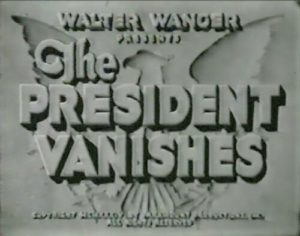 The mania for MIA politicians dates back to the 1930s. When first published by “Anonymous,” The President Vanishes was promoted as “A story so startling its author dared not sign his name.”
The mania for MIA politicians dates back to the 1930s. When first published by “Anonymous,” The President Vanishes was promoted as “A story so startling its author dared not sign his name.”
The year was 1934. Franklin Delano Roosevelt was chief executive. The county was still recovering from the horrors of the First World War. But there were menacing signs overseas – specifically, in Germany. Thus the saga of a peace-loving commander-in-chief who is trying to keep the United States from being dragged into a European war promoted by industrialists and businessmen. Then, he disappears …
By the time the film version was released in 1935, Rex Stout, creator of Nero Wolfe, had been outed as the unknown author.
The President Vanishes created a genre boilerplate.
**
Then there’s the popular scenario about efforts to create a puppet presidency.
The classic example is the 1959 novel, “The Manchurian Candidate.” Richard Condon’s mix of satire and suspense follows a former Korean War POW whose Communist Chinese captors subject him to brainwashing, and program him to kill (using a post-hypnotic trigger). The story climaxes with the attempted assassination of a presidential candidate. The book was originally likened to science fiction by reviewers.
The 1962 film adaptation was hyped with come-ons such as, “You’ll swear there’s never been anything like it!” Directed by 60’s wunderkind John Frankenheimer, the movie starred Laurence Harvey, Frank Sinatra, Janet Leigh and, as one of filmdom’s most infamous mothers, Angela Lansbury. Though Lansbury was nominated for an Academy Award for her performance, the movie divided the critics.
But with the November 1963 assassination of JFK, both book and film took on a prophetic mystique.
Within a month, Richard Condon was guesting on the Today show, discussing similarities between his book and real life. (Condon revisited the JFK assassination in 1974 with his thriller Winter Kills.)
In fact, government agencies did chase a theory involving the possible brainwashing of Lee Harvey Oswald. They called it “the Manchurian Candidate syndrome.”
Fiction and reality had collided.
**
The JFK assassination and revelations that followed, including details about the President’s secretive personal life, were game-changers for the political thriller. Likewise Watergate, the fall of Richard Nixon, the Iran-Contra affair, the Clinton-Lewinsky scandal … and the list goes on.
Already, the failure of the Cuban missile crisis had led to a spate of suspense titles examining Cold War threats, including Seven Days in May, about an attempted right-wing United States military coup. The 1962 book was co-authored by political columnist Fletcher Knebel (of the syndicated column “Potomac Fever”), who got his idea for the story after speaking to a hawkish Air Force general critical of the president’s handling of the Bay of Pigs. “Some thought he and others like him would have liked to overthrow the government,” Knebel recalled.
Seven Days in May was a best seller. The inevitable film version, released in 1964, starred Burt Lancaster, Fredric March, Kirk Douglas and Ava Gardner.
**
It was the death of JFK that sparked what crime editor-publisher Otto Penzler called, “Unequivocally the greatest espionage novel ever written by an American.” Its author, Charles McCarry, was a former CIA undercover agent – and a superlative storyteller.
Published in 1974, The Tears of Autumn proved startling for its plausible explanation of whodunit and why. (Spoiler Alert: It was the South Vietnamese, in retaliation for the assassination of their leader, President Ngo Dinh Diem. Kennedy and his advisers had played a role in the coup that led to Diem’s death, thereby resulting in the payback of JFK’s assassination.)
**
Depending on who you ask, the godfather of the political thriller is either Fletcher Knebel or Charles McCarry.
Knebel, who followed up Seven Days in May with at least another 10 novels, received renewed attention with the 2018 Vintage reprint of his yarn, Night of Camp David. About a mentally unbalanced president, it was first published in 1965, the same year that Congress passed the 25th Amendment, which mandates that the vice president shall succeed if a president cannot perform his or her duties. When Camp David was republished, some coverage posited if the topic – and situation – weren’t still timely.
Much of McCarry’s work continues to resonate. Especially Shelley’s Heart (1995), about a stolen election, and Lucky Bastard (1998), in which a curly-haired doughy-faced tomcatting president turns out to be a Soviet agent – and a rapist. The San Francisco Examiner labeled that one “a novelistic smear of President Clinton.”
McCarry could also be eerily prescient, as in 1979’s The Better Angels, which finds Arab terrorists hijacking planes for use as weapons. Critics of the day dubbed it “far-fetched.”
**
Similarly, reviewers deemed Tom Clancy’s Debt of Honor (1994) implausible, for a plot in which a vengeful Japanese national crashes a Boeing 747 into the Capitol. That perception changed on September 11, 2001. On that very evening’s broadcast of CNN’s America Under Attack, Clancy was an interviewee.
Clancy, who passed away in 2013, continues to be a superpower of the genre, with more than 17 bestsellers, film adaptations, and an ongoing franchise supporting his character, Jack “I’m just an analyst!” Ryan.
The presidency figures prominently in Clancy’s works – as when Ryan temporarily assumes the position when the chief executive and the rest of the powers-that-be are killed off, in the aforementioned Debt of Honor.
The author also has the distinction of being propelled to fame at least partly as a result of having a fan in the White House.
When President Ronald Reagan read Clancy’s debut novel, the 1984 techno-political thriller The Hunt for Red October, he famously called it, “my kind of yarn.”
So began Clancy’s rise.
No wonder he went on to write so passionately about power and politics.
As they say, truth is stranger than fiction – even when it’s beyond belief – or on the pages of a political thriller.
# # #
 back to writings
back to writings

